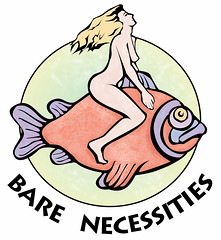 I didn’t intend to post today but felt compelled to share this so please take with me a brief respite from my “Shock and Awe” series and contemplate this offering.
I didn’t intend to post today but felt compelled to share this so please take with me a brief respite from my “Shock and Awe” series and contemplate this offering.Recently I happed to read an article published May 6, 2009, on NewsWithViews.com by Ellen Makkai. In the article, Ms. Makkai discussed her disagreement with the recent decision by the ACLU to defend “public nudity” as a First Amendment issue (freedom of speech) in connection with their intervention in Boulder, Colorado in the celebrated “Naked Pumpkin Runners” incident. She made quite plain her basis for disagreement by stating her own personal beliefs about the practice of nudity; “Last time I checked, my common sense said public nudity is not normal or practical”; and by inference terming public nudity an “indefensible fringe behavior.” While I disagree with Ms. Makkai’s views on nudity and actually consider her statement not only short-sighted but rather bizarre, that is not the subject I am addressing today. Later in her article, Ms. Makkai reasons that public nudity could not be protected speech or a First Amendment issue; “Strange, I don’t recall “public nudity” in my eighth-grade civics class during discussion of our Constitutional freedoms of expression.
‘Congress shall make no law…abridging the freedom of speech, or of the press; or the right of the people peaceably to assemble, and to petition the Government for a redress of grievances.’
Nope, no nudity mentioned there. Probably because our founding fathers never imagined its citizen elites would rally around public nudity as a civil right.
This newly suggested constitutional right defies logic. Even uninhibited three year-olds recognize propriety; they break into giggles, displaying a healthy embarrassment, when another tot cavorts in the raw.”
Certainly Ms. Makkai, a self-described “domestic right-wing extremist” is entitled to the public expression of her opinions about the practice of nudity, albeit negative ones but hardly qualified I think to take the educated lawyers of the ACLU to task on the topic of Constitutional law, since her only apparent claim to qualification to do so was her arguably limited education in such matters received during her “eighth-grade civics class” and her own “common sense.” The contents of her article show quite convincingly that she possesses little grasp on constitutional interpretation in general and the interpretation of the First Amendment in particular. In response to Ms. Makkai’s article, I must respectfully observe in all candor that it represents as sterling an example as one might imagine of the old adage, “It is better to keep silent and be thought a fool than to speak and remove all doubt.”
Perhaps the following discussion about “protected speech” under the provisions of the First Amendment might help to educate Ms. Makkai and others who might share her wrong-headed views. I will utilize one of the more celebrated and relatively recent United States Supreme Court cases dealing with “free speech” issues to help explain why nudity should clearly be a form of “protected speech” and a right under terms of the First Amendment. This case doesn’t deal directly with nudity but it contains valuable insight into the rights guaranteed by the First Amendment and demonstrates with clarity the similarities in legal theory between the issue of a person’s right to practice public nudity and the right of a person if they choose to engage in “flag burning” the subject of the case discussed.
Texas v. Johnson
Citations: 491 U.S. 397 (more) 109 S. Ct. 2533; 105 L. Ed. 2d 342; 1989 U.S. LEXIS 3115; 57 U.S.L.W. 4770
While the Republican National Convention was taking place in Dallas in 1984, Gregory Lee Johnson participated in a political demonstration dubbed the “Republican War Chest Tour.” The demonstrators were protesting the policies of the Reagan administration and of certain Dallas-based corporations. The demonstrators marched through the Dallas streets, chanting political slogans and stopping at several corporate locations to stage “die-ins” intended to dramatize the consequences of nuclear war. On several occasions they spray-painted the walls of buildings and overturned potted plants, but Johnson himself took no part in such activities. He did, however, accept an American flag handed to him by a fellow protestor who had taken it from a flagpole outside one of the targeted buildings. The demonstration ended in front of Dallas City Hall, where Johnson unfurled the American flag, doused it with kerosene, and set it on fire. After the demonstrators dispersed, a witness to the flag burning collected the remains of the burned flag and buried them in his backyard. No immediate breach of the peace ensued and no one was physically injured or threatened with injury, though several witnesses testified that they had been seriously and extremely offended by the flag burning. Johnson was convicted of desecration of a venerated object in violation of a Texas statute, sentenced to one year in prison, and fined $2,000. Johnson appealed the conviction. The Texas State Court of Appeals affirmed, however, the Texas Court of Criminal Appeals reversed, holding that the State, consistent with the First Amendment, could not punish Johnson for burning the flag under the circumstances finding that Johnson's burning of the flag was expressive conduct protected by the First Amendment. Texas appealed the reversal and eventually the case made its way to Supreme Court of the United States who heard the case in 1989 and handed down its decision. The opinion of the court came down as a controversial 5-4 decision with the majority opinion written by Justice William J. Brennan, Jr.
In deciding the case, the court first considered the question of whether the First Amendment reached non-speech acts, since Johnson was convicted of flag desecration rather than verbal communication, and if so, whether Johnson's burning of the flag constituted expressive conduct, which would permit him to invoke the First Amendment in challenging his conviction. The First Amendment literally prohibits the abridgment of “speech” only, but the court reiterated their long recognition that “protected speech” does not end at the spoken or written word. The court rejected the view that an apparently limitless variety of conduct can be labeled “speech” whenever the person engaging in the conduct intends thereby to express an idea (United States v. O'Brien, 391 U.S. 367), but acknowledged that conduct may be “sufficiently imbued with elements of communication to fall within the scope of the First and Fourteenth Amendments.” In deciding whether particular conduct possesses sufficient communicative elements to bring the First Amendment into play, the court identified two tests; is there clear intent to convey a particularized message; is the likelihood great that the message would be understood by those who viewed it.
The court found that, “Under the circumstances, Johnson's burning of the flag constituted expressive conduct, permitting him to invoke the First Amendment.” The court concluded that, while the government generally has a freer hand in restricting expressive conduct than it has in restricting the written or spoken word, “it may not ‘proscribe’ particular conduct because it has expressive elements.”
Texas had already conceded that Johnson's conduct was expressive in nature. Thus, the key question considered by the Court was whether Texas had asserted an interest in support of Johnson's conviction that was unrelated to the suppression of expression. The state defended its statute prohibiting the desecration of the American flag on two grounds: that states had a compelling interest in preserving a venerated national symbol; and that the state had a compelling interest in preventing breaches of the peace.
As to the breach of the peace justification; the court found that no disturbance of the peace actually occurred or was threatened because of Johnson burning the flag and rejected the claim on the part of Texas that flag burning is punishable on the basis that it tends to incite breaches of the peace, citing the familiar test of Brandenburg v. Ohio that the state may only punish speech that would incite “imminent lawless action.” Finding that flag burning does not always pose an imminent threat of lawless action and noting that Texas already punished “breaches of the peace” directly, the court rejected that argument. With regard to the second Texas argument, that states possess an interest in preserving the flag as a unique symbol of national identity and principles and that given desecration of the flag impugns its value as such a unique national symbol, the state possessed the power to prevent this result. In response, the court observed that no evidence could be found for “flag protection” in the Constitution and thus no existence of any claim of “uniqueness” could be imputed that would raise protection of the flag above the interests of protecting free speech. They answered the “uniqueness” claim directly: “We have not recognized an exception to [bedrock First Amendment principles] even where our flag has been involved...There is, moreover, no indication -either in the text of the Constitution or in our cases interpreting it- that a separate juridical category exists for the American flag alone...We decline, therefore, to create for the flag an exception to the joust of principles protected by the First Amendment.”
Justice Kennedy wrote an almost apologetic yet eloquent concurrence for Brennan's opinion: “For we are presented with a clear and simple statute to be judged against a pure command of the Constitution. The outcome can be laid at no door but ours. The hard fact is that sometimes we must make decisions we do not like. We make them because they are right, right in the sense that the law and the Constitution, as we see them, compel the result. And so great is our commitment to the process that, except in the rare case, we do not pause to express distaste for the result, perhaps for fear of undermining a valued principle that dictates the decision. This is one of those rare cases. Though symbols often are what we ourselves make of them, the flag is constant in expressing beliefs Americans share, beliefs in law and peace and that freedom which sustains the human spirit. The case here today forces recognition of the costs to which those beliefs commit us. It is poignant but fundamental that the flag protects those who hold it in contempt.”
In summary, the court concluded that the State could not criminally sanction flag desecration in order to preserve the flag as a symbol of national unity. It also held that the statute did not meet the State's goal of preventing breaches of the peace, since it was not drawn narrowly enough to encompass only those flag burnings that would likely result in a serious disturbance, and since the flag burning in this case did not threaten such a reaction. Further, it stressed that another Texas statute prohibited breaches of the peace and could be used to prevent disturbances without punishing this flag desecration. The court affirmed the decision of the Texas Court of Criminal Appeals in favor of respondent Johnson and invalidated laws prohibiting flag burning which were in force in 48 of the 50 states. Nearly two decades later, the issue remains controversial; recent polls suggesting that a majority of Americans still support a ban on flag-burning.
As a veteran of many years of past military service, I am a proud American who cherishes the way of life symbolized by the American flag. Even after more than five decades of living, I still become teary eyed when the national anthem of our country is played. Thus, personally I honestly admit that I consider the act of burning the American flag to be an appalling act that I’d neither condone nor encourage under any circumstances and would find significantly distressing to view. But I also agree with the decision of the United States Supreme Court that it isn’t something the state has any compelling interest in making unlawful or lawful power to sanction against. To paraphrase Justice Kennedy, the fact that we might not like something or even actually find it distasteful does not permit us to condemn something as wrong that is right in the sense that the law and the Constitution says it is permissible.
Tune in on Sunday, May 10, when I will present Part 2 of this article and examine the key elements of Texas v. Johnson as they relate to public nudity and First Amendment rights.







No comments:
Post a Comment